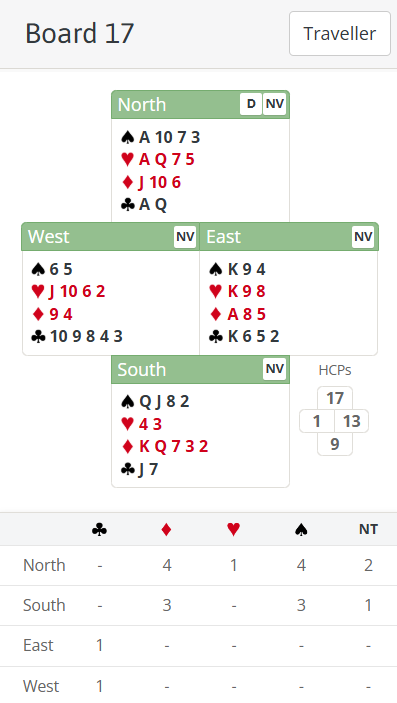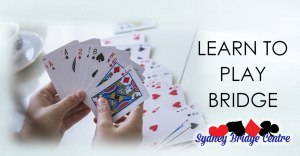City and Canada Bay – Thursday Morning 29th May 2025.

Stayman over 1NT is probably the most common bridge convention used in the entire world. But what happens after it gets far less attention. Board 17 last week is an example.
North opens 1NT. South certainly wants to investigate a spade fit and Stayman is the obvious start. North will respond 2♥. Now what?
The answer partly depends on how strong South is, and what agreements the pair may have. With 9 points and a 5422 shape opposite 15-17 South is worth game on this hand. So what he can, and should, do is jump to 3NT. The key thing to understand is that this sequence shows 4 spades. Why?
Because what was the point of South using Stayman? He hasn’t raised hearts so he doesn’t have those and if he didn’t have spades either there was no need to use Stayman at all – he would just bid 3NT directly over 1NT. Hence he must have spades. So North on this hand should now bid 4♠.
Note this is all because South was bidding game. What if he was weaker and just wanted to invite? He can bid 2NT over 2♥ to do that but he may also be able to bid 2♠ – see advanced section for more on invitational sequences here.
Something else to clarify after a response to Stayman is what does a new suit at the 3 level mean? For example 1NT-2♣-2♠-3♦? This can be played as weak (this sequence would show a weak hand with 4 hearts and 6+ diamonds – it was looking for a heart fit initially but now it hasn’t found one it wants to bail out in 3♦). Or it can be played as forcing – so a strong hand with 4 hearts and 5+ diamonds. Which you play is a matter of agreement – but it has a knock on effect as to what other sequences then mean – see advanced section for more.
What about the play? Let’s start with pairs that did end in 3NT. Some seemed to have scored a top by making as many as 11 tricks. But that shouldn’t have been the case! If East kicks off with a club, that goes round to declarer’s ♣Q but East has 3 more entries so will definitely have time to set the defence’s clubs up. The best declarer should be able to do is set up his 4 diamonds to go with 2 clubs and the two major aces – i.e. only 8 tricks. It may be that East didn’t play a 2nd club when in with ♦A but he can get some clues to help him – see advanced section for details.
4♠ was a more common contract. East has a horrible lead against that round to a strong NT – I’d probably start with a low trump in the hope of not giving anything away. The trouble is East will get back in and be in trouble again! He can’t lead clubs without giving a trick to ♣Q – but eventually declarer will be able to set his long diamonds up and discard the ♣Q on them anyway. So he should end up losing ♠K, ♥K and ♦A and make 10 tricks (he can discard one more heart on the long diamonds and ruff the 4th heart in the South hand).
Note that if East leads a club that doesn’t actually change anything – declarer no longer needs to discard ♣Q but that doesn’t help him because he can only discard 2 of his hearts on the long diamonds (one of which he could have ruffed in dummy anyway). So he’ll still lose a trick to ♥K. If, however, East switches to a heart then that WILL cost another trick as now declarer won’t lose a heart OR a club.
It can be seen that South can only make 3♠. That’s because West can lead a club which sets up the defence’s ♣K before declarer can discard his ♣Q on anything. Then, provided he is careful and just exits passively each time he gets in, East will score all 4 of his honour cards.
Key points to note
What happens after Stayman isn’t an area that is discussed that much – but it can be important.
If you bid Stayman, partner responds 2M and you now jump to 3NT you are showing 4 cards in the OTHER major (otherwise there was no point bidding Stayman to start with). So opener holding 44 in the majors can correct to 4♠ after 1NT-2♣-2♥-3NT
Invitational sequences can be different depending on your methods. It’s not necessary to play 1NT-2NT as invitational because you can go via Stayman first to show that. Playing 1NT-2♣-2♥-2♠ as invitational with 4 spades is also a useful method.
3 minor bids after a Stayman response can be played as weak or as forcing – worth agreeing! That has knock-on implications to what other bidding sequences mean which are worth more experienced pairs discussing.
When defending no-trumps, it’s basically a race to set your long suit up. It’s not always clear you have hit the jackpot and need to continue the suit you first led – but you can sometimes tell by how declarer played the suit. Think about what he might have done differently if he had the holding you are worried about.
More advanced
After 1NT-2♣-2♥ it’s a useful method to play that 2♠ shows 4 spades and an invitational hand. Opener can pass with a minimum and 4 spades or bid 2NT with a minimum without 4 spades. That means if responder continues with 2NT over 2♥ then he hasn’t got either major. So why did he bother with Stayman this time? It all depends what you play 1NT-2NT as. Initially most players play that as an invite but a more advanced treatment is to use it for something else (e.g. a transfer to diamonds). That’s possible because you can still show an invite by going via Stayman and THEN bidding 2NT (regardless of whether you hold a major or not). If a pair is playing that method then it that means there is no inference about responder holding the other major if he continues with 2NT after a 2M response – for example 1NT-2♣-2♠-2NT does not imply responder had hearts, it was the only way to show a 2NT invitational bid.
Observe how different this is to game sequences where, as we saw above, 1NT-2♣-2♥-3NT DID imply spades (and 1NT-2♣-2♠-3NT would imply hearts although in that sequence opener has already denied 4 hearts with his 2♠ bid).
I also talked about 3 level minor bids after Stayman. If you play them as weak then the knock on inference is that a transfer to the minor followed by 3M is natural and strong e.g. 1NT-2NT-3♦-3♥ (where 2NT is being played as a transfer to diamonds) shows a strong hand with 6+ diamonds and 4 hearts. If, however, you play 1NT-2♣-2♠-3♦ as forcing then you don’t need that transfer sequence to mean the same thing so it can be used for something else. A common choice these days is to play a minor suit transfer followed by 3M as shortage – seeking to help find a minor suit slam.
What does that lose? The ability to get out with a weak hand while also looking for a major fit. So a weak hand with 4 hearts and 6 diamonds now just has to transfer to diamonds as it has no way of stopping in 3♦ after going via Stayman. Like everything in bidding there’s a trade off!
I said in the play against 3NT that East should know to continue clubs. Trick 1 is likely to go ♣278Q (declarer won’t play ♣J from dummy because it would be a total giveaway when he has to overtake it himself!). That of itself may not tell East that declarer is missing the ♣9 and ♣10 because a strong declarer holding ♣AQ109 should conceal them and win the trick with ♣Q. But you might not be playing against a strong declarer in which case you can infer that because he’ll probably just win the trick with the cheapest card he can. West might also ask himself why declarer didn’t play ♣J from dummy which would look a much more natural thing to do if he held ♣AQ109? So there are some clues to continue with the ♣K. Another factor is East knows he has almost all the defence’s values so there’s very little chance of his partner getting in – in which case he may as well continue the original suit while he still has more entries.
West should also hold up the ♦A to the 3rd round – for 3 reasons:
- To cut off South’s winning diamonds (at least until declarer can force an entry there with spades)
- To get the count in diamonds (and find out declarer has 3)
- To get a signal from partner.
One thing West could do (although it costs a trick) is discard the ♣10 on ♦A. That would tell East he started with ♣1098 originally and enable East to continue ♣K safely. That would be 9 tricks for declarer – East would get in with ♠K so the defence would score 2 clubs, ♠K and ♦A. But that should still be OK as -400 should still score well compared to the -420 that those defending 4♠ are getting.
Another thing that may help is if the defenders are playing “Smith peters”. This is a method sometimes played against no-trumps where, on declarer’s first play, the defenders signal whether they liked or disliked their original lead (instead of the more common count signals). Here West would signal that he did like it and that makes the defence easy for East. Smith peters can be the only way to solve some hands but, as with everything, they can have downsides if the count is more important, or if the pips held make it hard to signal clearly. It’s also not always obvious to both defenders whether they think the opening lead should be continued!
Julian Foster (many times NSW representative) ♣♦♥♠



